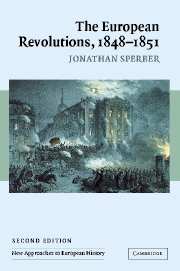Book contents
- Frontmatter
- Contents
- List of illustrations
- Preface to the second edition
- Chronology of events
- Introduction
- 1 Society and social conflict in Europe during the 1840s
- 2 The pre-revolutionary political universe
- 3 The outbreak of revolution
- 4 Varieties of revolutionary experience
- 5 Polarization and confrontation
- 6 The mid-century revolutions in European history
- Bibliography
- Short biographies
- Index
- NEW APPROACHES TO EUROPEAN HISTORY
2 - The pre-revolutionary political universe
Published online by Cambridge University Press: 05 June 2012
- Frontmatter
- Contents
- List of illustrations
- Preface to the second edition
- Chronology of events
- Introduction
- 1 Society and social conflict in Europe during the 1840s
- 2 The pre-revolutionary political universe
- 3 The outbreak of revolution
- 4 Varieties of revolutionary experience
- 5 Polarization and confrontation
- 6 The mid-century revolutions in European history
- Bibliography
- Short biographies
- Index
- NEW APPROACHES TO EUROPEAN HISTORY
Summary
The framework of political life
The typical characteristic of political life throughout Europe at the beginning of the 1840s was a negative one: the lack of republicanism and democracy. In an audacious outburst of experiment, late eighteenth-century revolutionaries had suggested that large, complex states could be ruled without a king and the years around 1800 had seen republican government at its greatest extent since classical antiquity. While a half-century later, this experiment continued in the Americas, in Europe it seemed to have been given up. The only republican governments were those covering small areas: the Swiss cantons, county-sized political entities bound together in a loose confederation, and the German city-states of Frankfurt, Hamburg, Bremen, and Lübeck, themselves only semi-autonomous parts of the larger German Confederation. Elsewhere, there were monarchs, who both reigned and ruled.
They ruled without counting on the consent of the governed. Even in those monarchies that possessed legislative bodies and a constitution or charter of privileges to empower them, the men who sat in them were scarcely the people's representatives. The franchise was restricted or exercised very inequitably. Nowhere was universal manhood suffrage a reality, to say nothing of women having the vote. The stringency of these limitations might be seen from conditions in France, where those possessing enough property to be eligible to vote in elections to the Chamber of Deputies, the lower house of the bicameral legislature, made up just 5 percent of all the adult males in the country.
- Type
- Chapter
- Information
- The European Revolutions, 1848–1851 , pp. 56 - 108Publisher: Cambridge University PressPrint publication year: 2005

